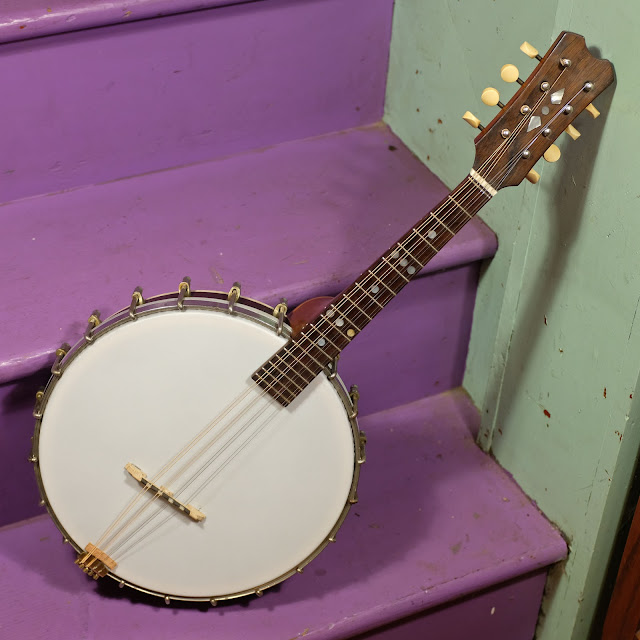1920s John Henry Parker "Tonebuilt" Banjo-Mandolin
When I pulled this banjo-mandolin out of its original case for the first time, I knew that I'd seen that headstock, inlay style, and skinny neck before on a trainwreck of a mandolin that'd been given to me years ago (and that I never fixed). It took me a while to scrounge it up in the brain, but Mugwumps' "antique luthiers" list helped me peg the Parker name while an old Mandolin Cafe messageboard post showed me pictures of a mandolin similar to the one I remembered and, finally, ye olde Fretboard Journal fleshed-out the rest in huge detail.
So, this Mr. John Henry Parker was a teacher, builder, and player who operated from Portland, ME, our own Burlington, VT, and finally Keene, NH -- where this instrument was likely built. He'd had a patent out for a secondary wooden soundboard mid-rim on banjos (with some sort of soundpost installed), but this banjo-mando features a metal disc with vents in place of a wooden board and features no soundpost. It's a curious design and, frankly, it actually works. I was surprised that it does but the vented disc seems to impart a less-raucous, more-clear sound compared to similar banjo-mandos without it. There's no tonering, though, so the instrument is automatically a little less-shrieky than your average jo-mando.
There are lots of things to admire about the design, really -- that weird disc, a zero fret nut, the thick rosewood fretboard, skinny Italian-bowlback-style neck and string spacing, and the cute lopsided pearl-dot inlay in the board and triangular bits in the headstock. It's even got a bead of white binding on the foot of the rim to make it look a little more "pro."
Work included: a fret level/dress, new Remo frosted-top head, replacement unplated No-Knot tailpiece, bolted neck joint modification, side dots install, replacement lightly-compensated bridge, cleaning, and a good setup. Its neck is straight and it plays perfectly with 1/16" action at the 12th fret. I have it strung with a custom set of gauges at 28w, 18w, 12, 8 -- a very thin set I use when I feel like a nudge just slightly lighter than the GHS A240 set (32w, 20w, 13, 9) will generate better sound on a banjo-mando. I don't like banjo-mandos to feel pushed if I can help it, and these gauges give the "springy" banjo sound and feel back to this one.
Scale length: 14"
Nut width: 1"
String spacing at nut: 7/8"
String spacing at bridge: 1 7/16"
Nut width: 1"
String spacing at nut: 7/8"
String spacing at bridge: 1 7/16"
Head diameter: 10 1/4" with new Remo frosted-top head
Side depth: 2 1/4"
Rim: ply maple
Neck wood: two-piece mahogany with center-stripe
Fretboard: rosewood
Neck wood: two-piece mahogany with center-stripe
Fretboard: rosewood
Neck shape: flat board with slim, soft-V rear
Bridge: maple/ebony/synthetic 1/2"
Nut: original bone
Tonering type: none -- raised thin half-round top to the rim
Condition notes: it's original throughout save replaced head, bridge, and tailpiece. I added a bolt/screw at the neck joint for durability but also reinstalled the original neck brace over it. It's quite clean throughout but there are a few wear marks here and there.
It comes with: its original hard case.
The old Waverly tuners are going strong. I like the clipped corners of the plates -- so that they'd fit the headstock.
The big, triangular heel reminds me of old Cole/Fairbanks instruments from the late 1800s.
Here's the neck brace. You can see the screw behind its backplate that's doing most of the work tightening the neck to the rim. I simply don't trust banjo-mando neck joints. The 8 strings and higher tension usually means traditional neck brace solutions just don't work very well. I'd rather have a little bit of ick in the looks to make it ship-shape and sturdy while it travels from gig to gig or jam to jam or cottage to cottage.
The original Waverly mandolin-style tailpiece will come with the instrument, but I prefer to use something like this No-Knot so loop or ball-end strings can be used. This new tailpiece isn't gold-plated -- it's raw brass, so it will tarnish and look more in-place over time.
The original hard case is in good health.



















Comments